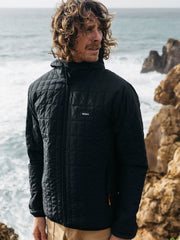In this excerpt from her new book, The Outdoor Swimmers' Handbook, OSS founder Kate Rew muses on the visceral experience of swimming in the sea. An exquisite guide for beginners and enthusiasts alike, The Outdoor Swimmers' Handbook will lead you to the shore and become your trusted companion for the adventures ahead. Buy your copy here.
The Outdoor Swimmers' Handbook: Understanding Seas
09.06.22
2 min read
Written by Kate Rew
Image by Niall Meehan
Entering the water at Dalkey Sound... captured by Niall Meehan.
The sea holds simple joys. Squinting into bright light with sea spray in our faces and the horizon in front of us gives humanity something so strong people have been self-medicating with the sea for ever. The buoyancy of it, the ions in the air, the constant swell and sway, push and pull: people form lifelong relationships with the sea and its uplift.
Beach swimming is not the whole story: the sea is also the landscape of some of swimming’s biggest adventures. There are crossings to make, distances to achieve, caves and coastlines to explore and experiences to have: night swimming in phosphorescence, snorkelling over kelp forests and coral. There are animals to meet, sea gardens to cruise over, islands to circumnavigate and rock features to explore. ‘Waves can turn the sea into the most spectacular and thrilling of wild swims, a natural fairground ride of wildness and surging energy,’ wrote Lynne Roper, an early member of the OSS team. Lynne loved the sea, how it would become unmanageable when a big set came through, or there was a sudden collision between a wave reflected from a reef or cliff with an incoming one. She thrived on having fun on the limits.
“It has a unique fascination. It’s a living thing. You never know what sort of conditions you are going to meet out there.”
Alison Streeter, 43-time Channel Swimmer, on the sea.
Some swimmers embrace its power and unruliness from the start; the feeling of their own insignificance is what they show up for. Being knocked off their feet and nudged about the ocean: it all helps create that sense of awe.
Others struggle with its essential lessons, which are all around control and our lack of it – if you want a practice ground for dealing with the unexpected when it happens, for choosing one thought over another, for adopting a learning stance in the face of disheartening reality, then the open sea is there for you. Whether it’s waves chopping up your lovely rhythmic stroke and making it hard to breathe, a tide pulling you crossly sideways, or a huge barrel jellyfish looming up beneath you as you swim across a bay, the sea has many ways to make it clear that it is bigger and stronger than us, and that the only thing in our control is our response to that.
To be a good sea swimmer takes experience that you can only acquire in the water. Big wave surfer (and swimmer) Al Mennie calls it ‘time served’. We can educate ourselves on the theory – the tides, currents, waves, chop, races and local weather. But the only way to become good sea swimmers is to serve our time, to develop a feeling for a huge body of water constantly on the bob and swell. Al has forty-one years of experience of his home beach to draw on – and countless other experiences – and says it’s still impossible to have enough information to be 100 per cent sure what the water will do when he enters it.




















































































